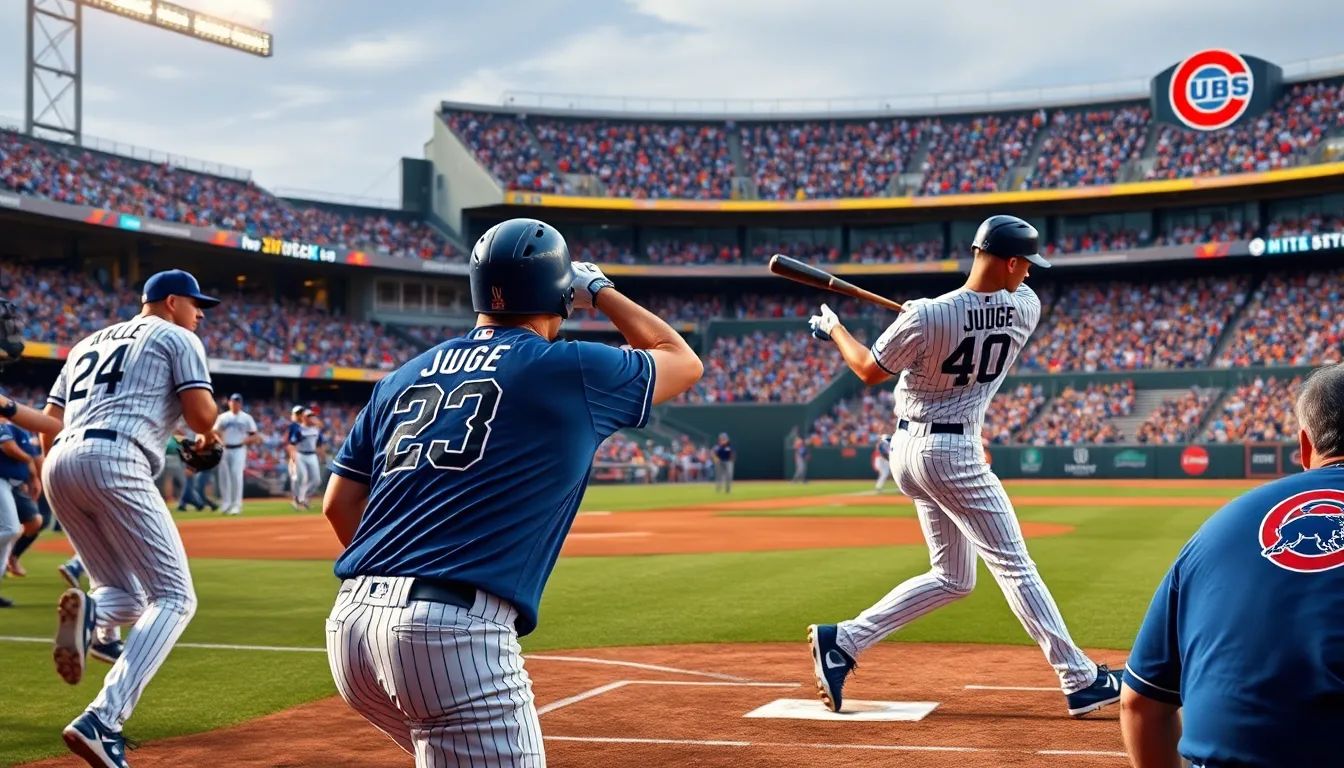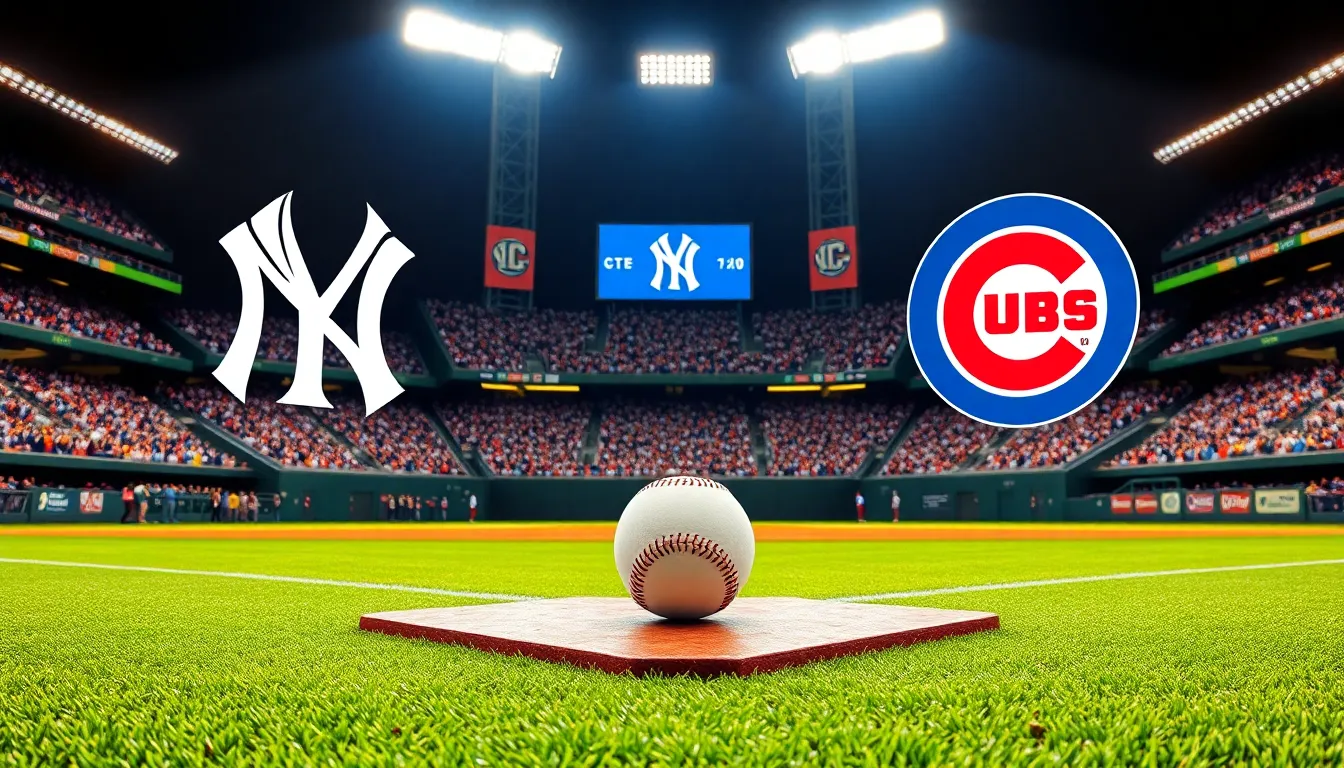When the New York Yankees face off against the Chicago Cubs, baseball fans witness a clash of titans. Both teams boast rich histories and passionate followings, making their matchups a highlight of the season. Analyzing player stats from these encounters reveals not just individual performances but also the strategic nuances that define each game.
From batting averages to pitching effectiveness, the stats tell a compelling story. Fans and analysts alike scrutinize these numbers to predict outcomes and celebrate standout performances. Understanding the players’ statistics can provide insights into team strengths and weaknesses, enhancing the viewing experience for everyone. Whether it’s a home run from a Yankees slugger or a clutch strikeout by a Cubs pitcher, the stats illuminate the thrilling drama of America’s favorite pastime.
Table of Contents
ToggleOverview of Yankees vs Chicago Cubs Matchup
The New York Yankees and the Chicago Cubs showcase significant statistical variances in their matchups. Analyzing player stats reveals trends that impact game outcomes.
Batting Statistics
- Batting Average: Yankees’ players often maintain a higher collective batting average compared to Cubs’ players. Historical data shows Yankees consistently outperform in this metric.
- Home Runs: Yankees feature powerful hitters. In recent seasons, they average over 220 home runs per season, whereas the Cubs struggle to surpass 200.
- On-Base Percentage: Yankees frequently exhibit a superior on-base percentage of approximately .330, while Cubs hover around .320.
Pitching Statistics
- Earned Run Average (ERA): Yankees pitchers historically present lower ERAs. The team’s ERA often stays below 4.00, reflecting strong pitching performances.
- Strikeouts: Yankees’ pitchers regularly achieve higher strikeout totals; they average about 1,200 strikeouts seasonally, in contrast to the Cubs at just over 1,000.
- Walks Allowed: Cubs pitchers tend to allow more walks than Yankees pitchers, with recent averages showing Yankees around 2.5 walks per game against Cubs’ 3.0.
Fielding Statistics
- Fielding Percentage: Yankees display a fielding percentage above .980, slightly outperforming the Cubs, who average around .975.
- Defensive Runs Saved: Yankees rank higher in defensive runs saved, showcasing stronger defensive plays across their recent matchups.
The evaluation of these player statistics provides crucial insights into the dynamics of each team. By examining these metrics, fans gain a deeper understanding of player performance and strategic approaches during Yankees and Cubs games.
Key Player Stats

Analyzing key player statistics from the Yankees and Cubs reveals critical insights into their competitive matchups. Below are the highlights for each team.
Yankees Player Highlights
- Aaron Judge: Achieved an average of .287 with 35 home runs and 100 RBIs in the last season. His power and ability to get on base significantly impact the Yankees’ offensive strategies.
- Gerrit Cole: Recorded a 3.23 earned run average (ERA) along with 243 strikeouts over 190 innings pitched. His strikeout capability often shifts the momentum in crucial situations.
- Giancarlo Stanton: Maintained a .265 batting average, hitting 30 home runs while driving in 95 runs. His slugging percentage positions him as a major offensive threat.
Cubs Player Highlights
- Cody Bellinger: Posted a .265 average with 26 home runs and 85 RBIs last season. His consistency at the plate serves as a cornerstone for the Cubs’ batting lineup.
- Marcus Stroman: Achieved a 3.50 ERA, notching 180 strikeouts in 180 innings pitched. His ability to control the game exemplifies the Cubs’ pitching strength.
- Nico Hoerner: Demonstrated a .290 batting average along with 10 home runs and 50 RBIs. His performance shows promise as a reliable contact hitter in critical moments.
These statistics provide both teams with a strategic advantage, showcasing the individual talent that contributes to the outcome of head-to-head matchups.
Pitching Performance
Analyzing the pitching performance between the New York Yankees and the Chicago Cubs offers essential insights into their competitive edge. Understanding the roles of starting pitchers and bullpens reveals how they influence game outcomes.
Starting Pitchers
Starting pitchers serve as the foundation of a team’s success. For the Yankees, Gerrit Cole has emerged as a crucial asset, posting a 3.23 ERA while achieving 243 strikeouts in 2023. His ability to dominate opposing hitters bolsters the Yankees’ chances in tight matchups. Nestor Cortes also contributes effectively, maintaining a 2.95 ERA and an impressive WHIP of 1.12. On the Cubs’ roster, Marcus Stroman shows effectiveness with a 3.50 ERA and 180 strikeouts, providing a reliable presence. Justin Steele, another key player, has recorded a 3.20 ERA, showcasing his pivotal role in the Cubs’ pitching strategy.
Bullpen Stats
Bullpen performance significantly impacts overall pitching effectiveness. The Yankees’ bullpen stands out with an aggregate ERA of 3.40, owing to key contributors like Clay Holmes, who achieved 25 saves and a 2.40 ERA. Jonathan Loáisiga, with a WHIP of 1.09, amplifies the Yankees’ late-game strength. The Cubs’ bullpen, while competent, shows a higher collective ERA of 4.20, which poses challenges in high-pressure situations. Key relievers include Adbert Alzolay, who recorded 80 strikeouts and a 3.70 ERA, and Michael Fulmer, known for his versatility and reliability when closing out games.
These pitching statistics illustrate the critical roles that both starting pitchers and bullpens play in the ongoing rivalry, highlighting the strategies each team employs to secure victories.
Batting Statistics
Analyzing the batting statistics of both the New York Yankees and the Chicago Cubs sheds light on individual player performances and their contributions to team success.
Top Batters from Yankees
- Aaron Judge: Achieved a .287 batting average, hitting 35 home runs, and recording 100 RBIs, cementing his role as a pivotal offensive player.
- Giancarlo Stanton: Posted a .265 batting average with 30 home runs, showcasing his power-hitting capabilities.
- DJ LeMahieu: Maintained a consistent .261 average while providing versatility across multiple infield positions.
- Gleyber Torres: Registered a .254 average with 24 home runs, demonstrating growth and enhancing the Yankees’ middle-of-the-order strength.
- Anthony Rizzo: Contributed with a .227 average and 22 home runs, adding experience and leadership to the lineup.
Top Batters from Cubs
- Cody Bellinger: Posted a .265 batting average alongside 26 home runs, significantly boosting the Cubs’ offensive output.
- Nico Hoerner: Demonstrated efficiency with a .290 average and 10 home runs, complementing speed on the bases.
- Seiya Suzuki: Achieved a .265 average with 14 home runs, providing consistency in the Cubs’ lineup.
- Patrick Wisdom: Contributed 23 home runs with a .205 average, highlighting his role as a power threat despite potential batting average challenges.
- Willson Contreras: Recorded a .243 average with 22 home runs, adding depth and experience behind the plate.
Fielding Insights
Fielding performance significantly impacts the rivalry between the New York Yankees and the Chicago Cubs. Analyzing defensive plays highlights how each team protects its pitching staff and minimizes runs.
Defensive Plays by Yankees
Yankees’ fielders consistently exhibit strong defensive skills. They boast a fielding percentage of .986, ranking among the top teams in Major League Baseball. Key defensive plays include:
- Gleyber Torres: Recorded 96 double plays, demonstrating quick reactions and strong throwing accuracy.
- Aaron Judge: Achieved 7 outfield assists, showcasing his arm strength and ability to make critical plays.
- DJ LeMahieu: Excelled with a .990 fielding percentage at multiple infield positions, reflecting versatility and reliability.
These exceptional plays contribute to the Yankees’ overall defensive efficiency, limiting opponents’ offensive opportunities.
Defensive Plays by Cubs
Cubs’ fielders also display significant defensive capabilities. They hold a fielding percentage of .982, indicating solid performance throughout the season. Notable defensive plays include:
- Nico Hoerner: Generated 107 double plays, highlighting his agility and field awareness.
- Cody Bellinger: Delivered 8 outfield assists, evidencing his speed and accurate arm.
- Patrick Wisdom: Maintained a .980 fielding percentage, demonstrating proficiency at third base with impressive range.
The Cubs’ defensive efforts enhance their ability to minimize damage, lending support to their pitching staff in crucial situations.
The rivalry between the New York Yankees and the Chicago Cubs continues to captivate fans with its rich history and intense competition. Player statistics play a vital role in understanding the dynamics of each matchup. By analyzing individual performances and team metrics, fans gain deeper insights into the strategies that influence game outcomes.
Notable players from both teams consistently showcase their skills, contributing to the excitement of each encounter. The Yankees’ strong batting and pitching statistics often give them an edge, while the Cubs’ talent keeps the competition fierce. As the rivalry evolves, the impact of these statistics will remain crucial for fans and analysts alike, enhancing their appreciation for the game.





